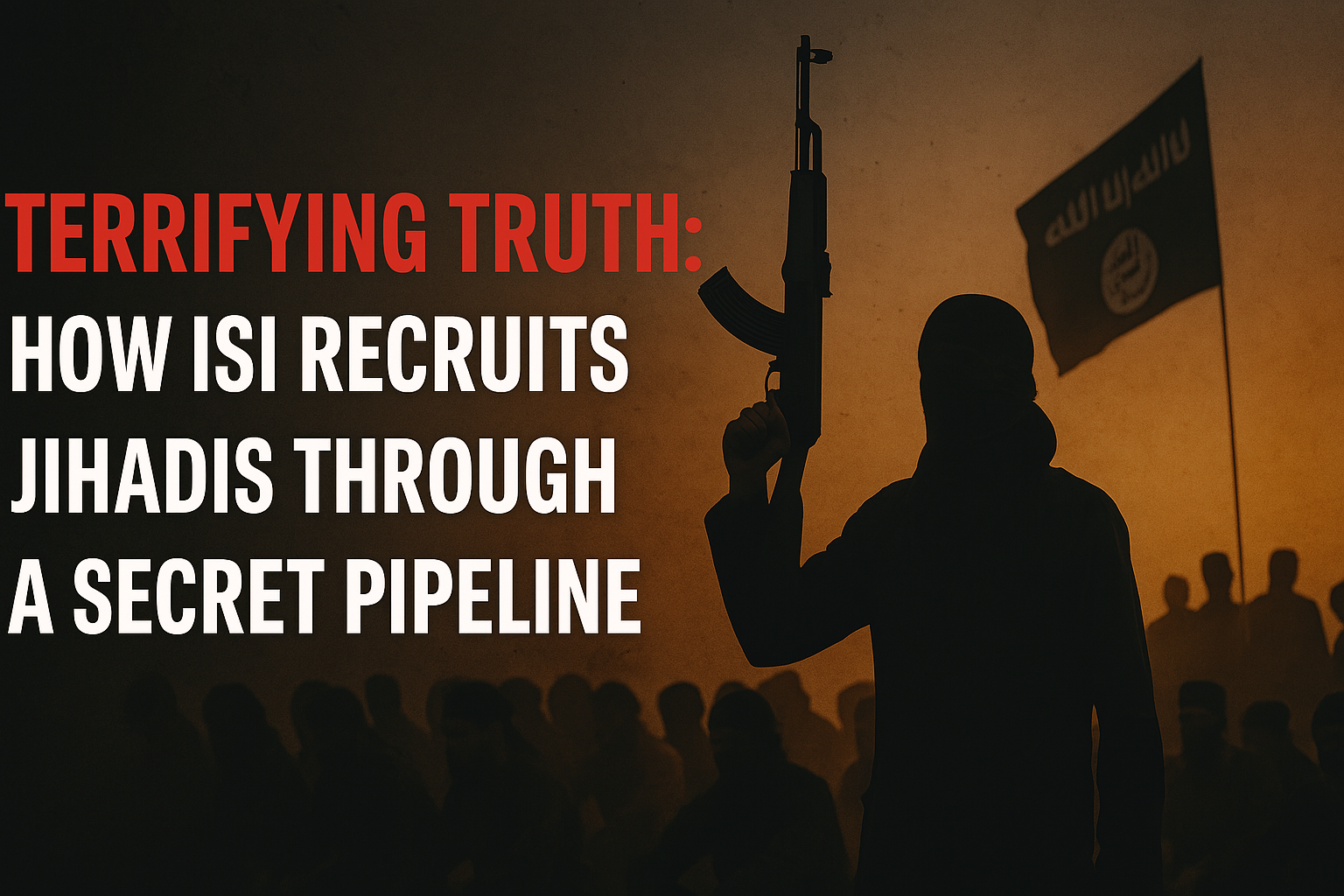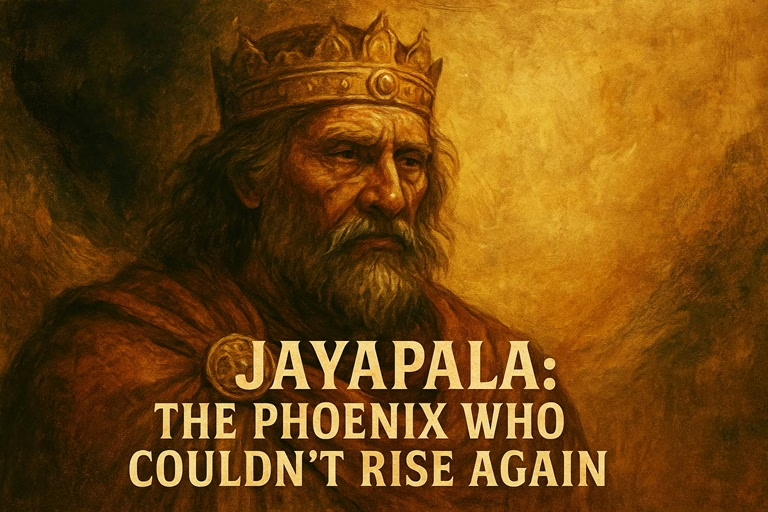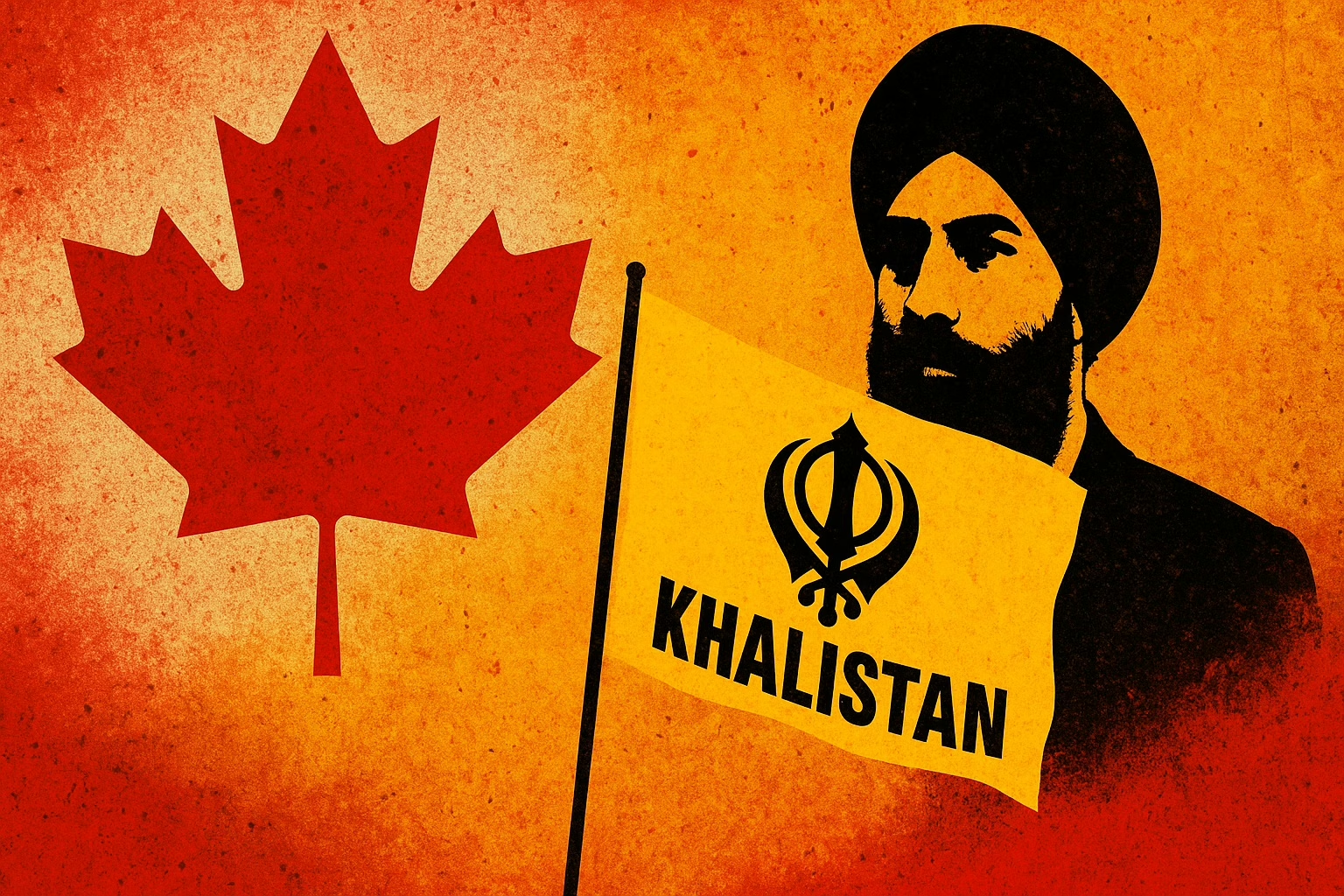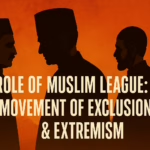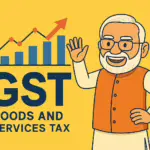When you think of Canada, you probably imagine maple syrup, polite neighbors, and freezing hockey rinks—not a breeding ground for separatist propaganda and terrorist sympathies. But peel back the flannel, and you might just find a colder truth: Canada has long served as a welcoming haven for misfits, fugitives, and ideological outlaws — a pattern that culminates today in the rise of the Khalistan Movement in Canada.
And no, this isn’t a recent development. The roots go deep—far deeper than Jagmeet Singh’s Instagram captions or Justin Trudeau’s glossy photo-ops. The story of the Khalistan Movement in Canada is tangled in geopolitics, moral decay, vote-bank politics, and an enduring Canadian tradition—harboring questionable characters in the name of freedom and multiculturalism.
Let’s unpack this politely packaged chaos.
Canada and Criminals: How It Set the Stage for the Khalistan Movement in Canada
If there were Olympic golds for hosting fugitives, Canada would have a podium monopoly. The seeds of today’s Khalistan Movement in Canada were planted as early as the 1770s, when criminals fleeing the American Revolution found refuge in the snowy comfort of South Ontario. Canada didn’t just let them in—they gave them citizenship.
This isn’t just a fun historical tidbit. It defines a philosophy: Canadian leniency masked as liberalism.
Criminals, Maple Leaves, and the 1770s
Canada’s warm hospitality for crooks isn’t new. After the American Revolution, many criminals from the newly independent United States crossed into Canada. Rather than send them back or even verify their backgrounds, Canadian authorities rolled out the red carpet and gave them citizenship. Why? Because Canada was still shaping its identity—what better way than to stock up on morally flexible individuals?
This early example isn’t just historical trivia—it sets the tone for Canada’s immigration policies, especially toward groups with complex political backgrounds.
How the Sikh Population Fed the Khalistan Movement in Canada
Post-World War I, many Sikh soldiers left the British Army and started farming in Canada. By the 1970s, there was a flourishing Sikh-Punjabi community. After India’s independence in 1947, relations with Canada were initially warm. Canada even shared nuclear technology and Uranium reserves with India.
But in 1974, India tested its first nuclear weapon (Operation Smiling Buddha). That’s when Pierre Trudeau—father of current PM Justin Trudeau—turned cold.
He didn’t just react with sanctions. He began seeing India through a distorted lens, helping incubate what we now know as the Khalistan Movement in Canada.
From Soldiers to Settlers: The Sikh Migration Wave
In the early 20th century, many Sikh soldiers from the British Indian Army moved to Canada. By the 1930s, they had set up farms and began integrating into Canadian society. Fast forward to the 1970s, and the Sikh population in South Ontario had grown substantially. Nothing inherently wrong here—until geopolitics entered the picture.
India had just gained independence in 1947 and was building strong diplomatic ties with Canada. Canada, with its generous uranium reserves, even assisted India in nuclear technology during the 1950s.
But then came 1974. Enter Pierre Trudeau. Exit reason.
A Faultline Exploited: Punjab’s Turmoil Meets Canadian Opportunism
Punjab in the 1970s wasn’t just fertile ground for wheat; it was also ripe for radicalization. With Congress sidelining the Akali Dal, and wealth from the Green Revolution unevenly distributed, unrest grew. Enter Jarnail Singh Bhindranwale, who exploited moral degradation and economic frustration.
It all spiraled into Operation Bluestar in 1984. Then came Indira Gandhi’s assassination and the horrific anti-Sikh riots. That tragedy triggered a massive exodus of Sikhs from India. Where did many of them go?
You guessed it—Canada.
Pierre Trudeau and the Rise of the Khalistan Movement in Canada
When India tested its first nuclear bomb under Operation Smiling Buddha in 1974, Pierre Trudeau took it personally. The bilateral relationship soured. Trudeau Sr., in an attempt to flex his political muscles and poke India in the eye, began entertaining the Khalistan faultline—a simmering issue that needed statesmanship, not saboteurs.
Meanwhile, in Punjab, India, the Congress Party had begun to sideline Akali Dal, thanks to the Green Revolution. But economic prosperity couldn’t mask the growing moral and cultural vacuum in the state. This was the soil in which Jarnail Singh Bhindranwale planted his radical ideology.
Bhindranwale and the Exodus That Fueled the Khalistan Movement in Canada
By the late 1970s, Bhindranwale was fueling separatist fire, exploiting Punjab’s inequalities and frustration. The situation escalated and led to Operation Bluestar in 1984—India’s military intervention at the Golden Temple to flush out armed separatists.
Then came the assassination of Indira Gandhi and the tragic anti-Sikh riots of 1984. Thousands of Sikhs fled India—many of them landing in, you guessed it, Canada.
Canada, rather than vet these incoming refugees, handed out entry passes like Diwali sweets. Background checks? Minimal. Intent verification? Non-existent. The result? A political constituency rooted not in integration, but in grievance, revenge, and radical ideology.
The Rise of the Khalistan Movement in Canada
Canada didn’t even bother vetting these new immigrants. Their pain was real, but the background checks were not. As Sikh migration ballooned, it created a voter bloc. Suddenly, transnational Sikh organizations sprouted:
- World Sikh Organization (WSO)
- Canada Sikh Organization
- Sikhs for Justice (SFJ)
By the late 1990s, the agenda was no longer about cultural preservation. It was about revenge, separatism, and political bargaining.
And guess where they set up camp? Canada—the land of free healthcare and freely given visas.
Post-Insurgency Punjab: A Different Problem, A Similar Flight
In the 2000s, Punjab’s wounds were healing, but a new menace emerged—drugs. Fueled by Pakistan’s ISI and porous borders, heroin and synthetic substances infiltrated even the smallest villages.
Desperate families saw only one way out: Canada. But this time, things weren’t so easy. Canadian immigration grew stricter, especially for unskilled youth.
Enter the Arsh Dalla Gang and other human smugglers, illegally ferrying Punjabi youth to Canada and forming an Indo-Canadian underworld.
A New Weapon: Culture Turned into Chaos
Between 2014–2017, a disturbing trend took off. Punjabi pop culture became saturated with:
- Guns
- Gangsta glamour
- Drug glorification
- Vulgar lyrics
Behind these viral videos were Canadian producers and funding from alleged ISI sympathizers. The plan was genius—turn art into ammunition, and songs into social sabotage.
And while Punjab bled, Canada monetized the music.
Drugs, Gangs, and the New Exodus
While Punjab found temporary peace in the late 1990s, a new monster was born: the drug menace. Fueled by cross-border smuggling from Pakistan, drugs began pouring into Punjab. With bleak job prospects, families looked toward Canada once again for salvation.
But this time, Canada wasn’t easy to enter legally. So, gangs like the Arsh Dalla network began smuggling Punjabi youth into Canada, forming a fresh underworld nexus. And lurking behind the scenes? The Inter-Services Intelligence (ISI) of Pakistan. To fully understand the ISI’s strategy behind destabilizing regions like Punjab and empowering radical elements abroad, read our detailed exposé on how ISI recruits jihadis through a sinister pipeline.
ISI’s strategy was simple: use Canadian soil to destabilize India. Radicalized youth + drug addiction + economic despair = perfect ingredients for separatism redux.
3M’s: Music, Murder, and Microphones
From 2014 to 2017, something curious happened. Violent, vulgar Punjabi music exploded on YouTube. Singers who glorified gun culture, gangs, and drugs were suddenly stars. Many had direct links to Canadian artistic societies and music labels.
Coincidence? Hardly. This was a coordinated cultural assault. Canada and ISI were weaponizing art—turning music into militant messaging.
This wasn’t art. This was algorithmic radicalization.
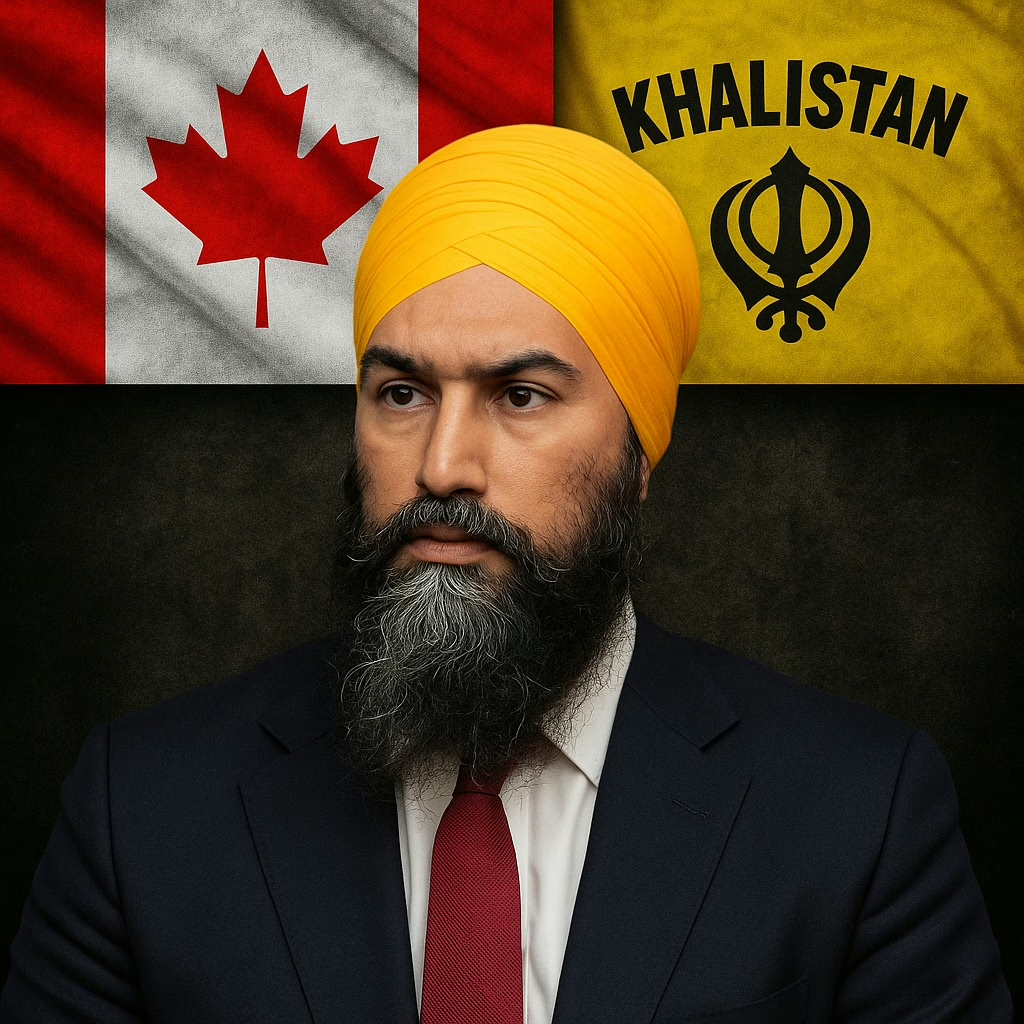
Jagmeet Singh and His Role in the Khalistan Movement in Canada
Let’s talk about Jagmeet Singh, the leader of Canada’s New Democratic Party (NDP).
Enter Jagmeet Singh—the turbaned, tailored face of Canada’s New Democratic Party (NDP). A lawyer by profession and a politician by ambition, Singh quickly realized the power of the Sikh vote. And instead of distancing himself from Khalistani rhetoric, he doubled down on it.
With a turban on his head and Khalistan in his heart, Singh built his political career pandering to the separatist base in Canada. Instead of promoting harmony, he:
- Refused to denounce Bhindranwale as a terrorist
- Blamed India for 1984 without context
- Openly supported Khalistan rallies
- Teamed up with Trudeau’s Liberal Party to secure Sikh votes
Yes, the man claiming to represent Canadian values indirectly enabled transnational extremism. Ironically, while Indian Sikhs moved on, Jagmeet Singh stayed stuck in the 1980s.
India Fights Back—Finally, Someone Called It Out And Canada Cries Foul
As radical groups became bolder, India fought back—hard. It exposed:
- Foreign funding channels
- Radical content on social media
- Illegal referendums held on Canadian soil
- Involvement of known ISI assets
Canada, rather than clean up the mess, threw a hissy fit about freedom of speech. Apparently, plotting against a sovereign state now qualifies as “expression.”
But instead of cooperating, Canada threw a tantrum. Trudeau accused India of suppressing free speech. Singh cried foul. And the Canadian government… cried sovereignty.
All this while ordinary Canadians began questioning: Who governs Canada? The Prime Minister or the PMO of Pakistan?
India didn’t buy it. And increasingly, neither did Canadians.
Trudeau, Tearful Jagmeet & Domestic Disillusionment
Canadians began asking real questions. Why were their leaders ignoring issues like:
- Sky-high inflation
- Housing shortages
- Healthcare backlogs
All to appease a small but vocal segment of Khalistani extremists?
Trudeau, already infamous for calling Canada “America’s 51st state,” lost credibility. And Jagmeet Singh? After a poor election showing, he cried on national television. The Khalistani script hadn’t played well with the Canadian mainstream. The very people he tried to mobilize saw through the veneer.
But the damage was done.
The Canadian Legacy: From Criminal Safehouse to Extremist Playground?
So will Canada support Khalistan? If history is any indicator—yes. From harboring American criminals in the 1770s to ignoring drug smugglers in 2020s, Canada has always put its liberal halo above international responsibility.
For India, the lesson is clear. The Khalistan Movement in Canada is not about Sikh rights—it’s about political opportunism, foreign manipulation, and a dangerous cocktail of historical grievances mixed with modern-day ignorance.
Will Canada Still Support Khalistan?
That’s the million-rupee question. But history doesn’t lie.
- 1770s: Took in American criminals
- 1980s: Embraced unverified political refugees
- 1990s: Let separatist groups bloom
- 2000s: Became a gangland paradise
- 2010s: Weaponized Punjabi pop culture
- 2020s: Hosts Khalistani referendums like Sunday brunches
So, will Canada support Khalistan? Sadly, it already has—passively, actively, and politically.
What India Must Learn (and Do)
India can’t control Canadian politics, but it can:
- Clamp down on illegal funding to separatist groups
- Block radical content online at the source
- Build stronger alliances with moderate Canadian voices
- Continue exposing the ISI-Khalistan-Canada nexus
- Offer better opportunities for Punjabi youth to eliminate the push factors
Canada may choose chaos. But India can choose resilience.
Final Word: Khalistan is Dead. Long Live Common Sense.
The Khalistan Movement in Canada is less about Sikh rights and more about political theater. It’s a grotesque blend of victimhood, foreign interference, and local vote-bank politics.
Most Indian Sikhs don’t want Khalistan. They want jobs, peace, and prosperity. The only ones still selling the Khalistani dream are politicians like Jagmeet Singh, and puppet masters who profit from division.
So next time Trudeau or Jagmeet cries “freedom,” ask them—freedom for what? Separatism? Terrorism? Or TikTok politics?






